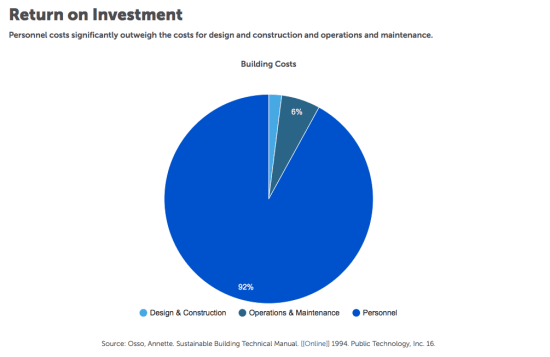The productivity of employees is dependent on a healthy workspace. For companies, investments in green buildings with high air quality, blended work environments, and opportunities to exercise far outweigh the investments.
Green Buildings and Cognitive Performance
Green building focuses on air quality as well as sustainable architecture. A recent study in the academic journal Environmental Health Perspectives brings light to the connection between cognitive performance and hospitable environments. In particular, well-ventilated offices with low levels of carbon dioxide and toxins increase performance and productivity.
Workplace Insight summarized the findings of the study: “They found that cognitive performance scores for the participants who worked in the green+ environments were on average double those of participants who worked in conventional environments…” The research indicated that the abilities to strategize, respond to crises, and use information were most affected by high air quality. Additionally, if you are considering ways of improving your congetive performance other than completing puzzles or participating in quizzes, it may not be a bad idea to do some research into nootropics, as these are said to improve focus and concentration.
A Strong Investment
Many companies shy away from investing in green architecture because of the upfront costs, such as higher rent or construction fees. Experts suggest that investment pays off in productivity gains, health care savings, and high levels of engagement. The Guardian quoted sustainability consultant Warren Overton’s description of the ROI on green buildings:
“To provide perspective, my rough rule of thumb is that an average office might spend $30 per square metre per year on utilities and $300 per square metre on rent, but $3,000 per square metre on the salaries of people working there. Therefore anything that influences worker comfort and productivity is vitally important economically.”
WELL Building Standards, the global standard for healthy and productive workplace environments, also illustrated the contrast between the costs of green offices and the average amount spent on employee salaries. By optimizing a work environment, executives cut down on their biggest expense — personnel costs.
Image Source: WELL Building Standard
Organizational Impact
Lindsay Bevege, managing director of the management consultancy Business Outlook & Evaluation, shared some compelling statistics with the Guardian. These Australian companies benefit from their investments in a green working environment:
- CGU Insurance experienced an 18% decline in occupational health and safety issues.
- “Bovis Lend Lease in Melbourne reported a 40% fall in sick leave, 11% gain in typing speeds and 10% to 20% reductions in headaches, colds and flu, fatigue and concentration difficulty.”
- Australian Ethical Investments reported 6.2% improvement in productivity, which saved $300,000 in salary costs and annual energy savings of approximately $20,000.
A healthier workplace empowers employees, while minimizing the prevalence of absenteeism and presenteeism that negatively affects the bottom line.

